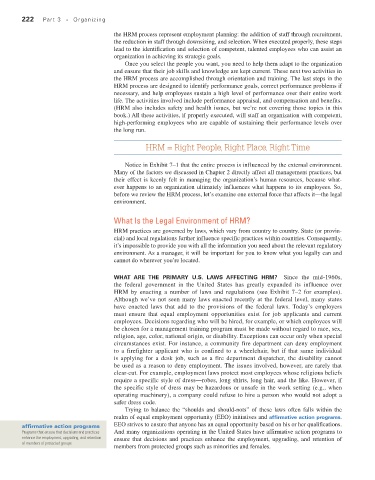Page 223 - Fundamentals of Management Myths Debunked (2017)_Flat
P. 223
222 Part 3 • Organizing
the HRM process represent employment planning: the addition of staff through recruitment,
the reduction in staff through downsizing, and selection. When executed properly, these steps
lead to the identification and selection of competent, talented employees who can assist an
organization in achieving its strategic goals.
Once you select the people you want, you need to help them adapt to the organization
and ensure that their job skills and knowledge are kept current. These next two activities in
the HRM process are accomplished through orientation and training. The last steps in the
HRM process are designed to identify performance goals, correct performance problems if
necessary, and help employees sustain a high level of performance over their entire work
life. The activities involved include performance appraisal, and compensation and benefits.
(HRM also includes safety and health issues, but we’re not covering those topics in this
book.) All these activities, if properly executed, will staff an organization with competent,
high-performing employees who are capable of sustaining their performance levels over
the long run.
HRM = Right People, Right Place, Right Time
Notice in Exhibit 7–1 that the entire process is influenced by the external environment.
Many of the factors we discussed in Chapter 2 directly affect all management practices, but
their effect is keenly felt in managing the organization’s human resources, because what-
ever happens to an organization ultimately influences what happens to its employees. So,
before we review the HRM process, let’s examine one external force that affects it—the legal
environment.
What Is the Legal Environment of HRM?
HRM practices are governed by laws, which vary from country to country. State (or provin-
cial) and local regulations further influence specific practices within countries. Consequently,
it’s impossible to provide you with all the information you need about the relevant regulatory
environment. As a manager, it will be important for you to know what you legally can and
cannot do wherever you’re located.
What are the Primary U.S. LaWS affecting hrm? Since the mid-1960s,
the federal government in the United States has greatly expanded its influence over
HRM by enacting a number of laws and regulations (see Exhibit 7–2 for examples).
Although we’ve not seen many laws enacted recently at the federal level, many states
have enacted laws that add to the provisions of the federal laws. Today’s employers
must ensure that equal employment opportunities exist for job applicants and current
employees. Decisions regarding who will be hired, for example, or which employees will
be chosen for a management training program must be made without regard to race, sex,
religion, age, color, national origin, or disability. Exceptions can occur only when special
circumstances exist. For instance, a community fire department can deny employment
to a firefighter applicant who is confined to a wheelchair, but if that same individual
is applying for a desk job, such as a fire department dispatcher, the disability cannot
be used as a reason to deny employment. The issues involved, however, are rarely that
clear-cut. For example, employment laws protect most employees whose religious beliefs
require a specific style of dress—robes, long shirts, long hair, and the like. However, if
the specific style of dress may be hazardous or unsafe in the work setting (e.g., when
operating machinery), a company could refuse to hire a person who would not adopt a
safer dress code.
Trying to balance the “shoulds and should-nots” of these laws often falls within the
realm of equal employment opportunity (EEO) initiatives and affirmative action programs.
affirmative action programs EEO strives to ensure that anyone has an equal opportunity based on his or her qualifications.
Programs that ensure that decisions and practices And many organizations operating in the United States have affirmative action programs to
enhance the employment, upgrading, and retention ensure that decisions and practices enhance the employment, upgrading, and retention of
of members of protected groups
members from protected groups such as minorities and females.

